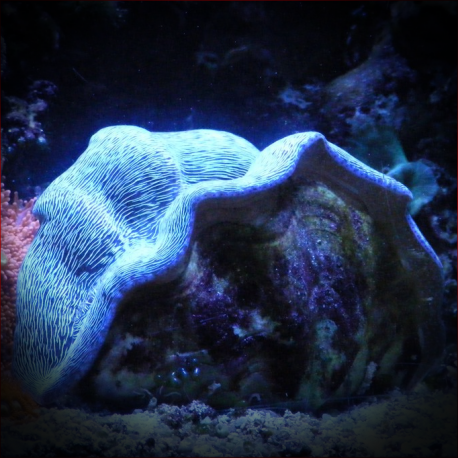More info
Datasheet
| Minimum Tank Size | 200 litres / 52.83 US gallons |
| Maximum Size | 60.0cm / 23.62inches |
| Reef Compatible | Always reef safe |
| Temperament | Peaceful |
| Temperature | 22.2°C / 71.96°F - 25.6°C / 78.08°F |
| Specific Gravity | 1.020-1.025 |
| Carbonate Hardness | 8-12 |
| pH | 8.1-8.4 |
General Description
The Derasa Clam, scientifically known as Tridacna derasa, is a larger and hardy species of clam that can grow to considerable size under suitable conditions. Identified by the presence of 6-7 vertical folds on their shells, these clams are known for their ease of care and vibrant colors.
Aquarium Suitability
Considered suitable for aquariums with proper care, the Derasa Clam requires high water quality and bright illumination. They are peaceful in temperament but should be kept away from fish and invertebrates that may damage them.
Demands, Care, and Hardiness
This species thrives in aquariums with a minimum tank size of 200 liters and water conditions maintaining a pH of 8.1-8.4, a specific gravity of 1.020-1.025, a temperature range of 22.2-25.6°C, and a carbonate hardness of 8-12 dKH. They demand high water quality and benefit from proper oxygenation within the tank.
Reef Suitability
Derasa Clams are known to be reef-safe, making them a suitable addition to reef aquariums. They do not pose a threat to the coral or other inhabitants within the reef environment.
Aquarium Setup
When setting up an aquarium for the Derasa Clam, it is essential to provide powerful lighting and ensure calcium levels in the water are between 400 and 440 ppm. Placing the clam in the sand or a secure location is recommended to prevent toppling. Regularly checking for pyramid snails near the clam's foot is advised, as these can pose a threat to the clam's well-being.
Behaviour
Over time, Derasa Clams will attach themselves to rocks or sand within the aquarium. Care should be taken to avoid damaging the clam's foot during any movement. Healthy clams will react promptly to shadows by retracting, indicating their well-being.
Feeding and Diet
Smaller clams (<4 inches or <10 cm) should be fed phytoplankton until they grow larger, while larger specimens primarily derive nutrition from photosynthesis. Supplementary feeding with phytoplankton is beneficial for larger clams. Additionally, some Wrasses can help eliminate pyramid snails that may threaten the clam's health.
Dimorphism and Captive Reproduction
Derasa Clams can be bred in captivity, providing aquarists with the opportunity to acquire captive-bred specimens through local fish stores. Captive reproduction is an encouraging sign of sustainable practices within the aquarium hobby.
Habitat and Distribution
In the wild, the Derasa Clam is found in the East Indian Ocean, Australia, Indonesia, and the Central/West Pacific regions. Its natural habitat consists of tropical waters where it plays a vital ecological role in the marine ecosystem.

